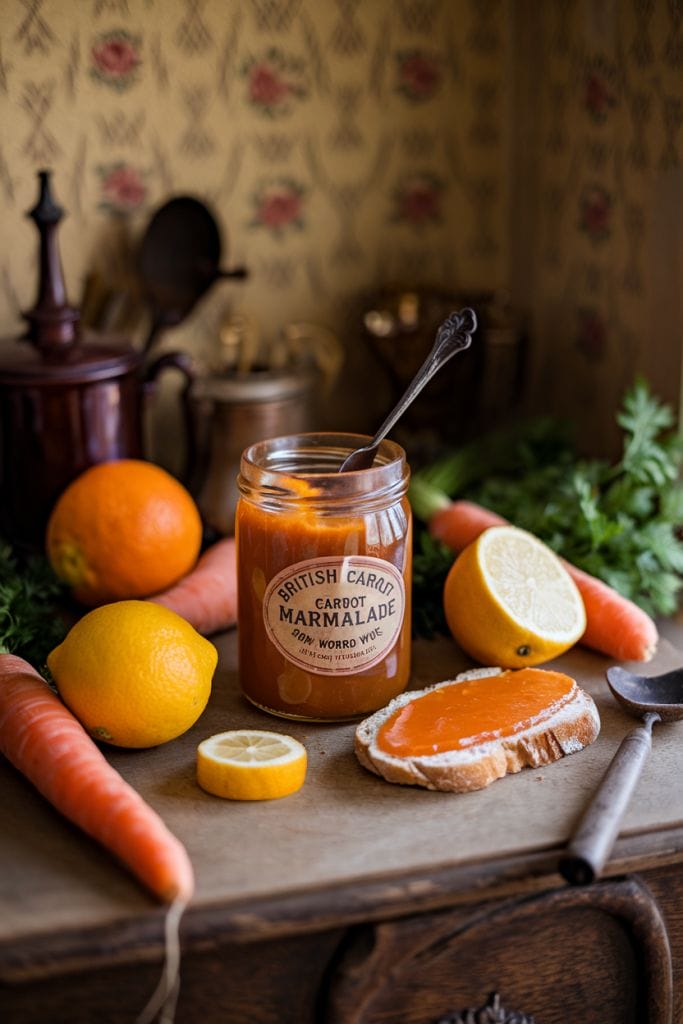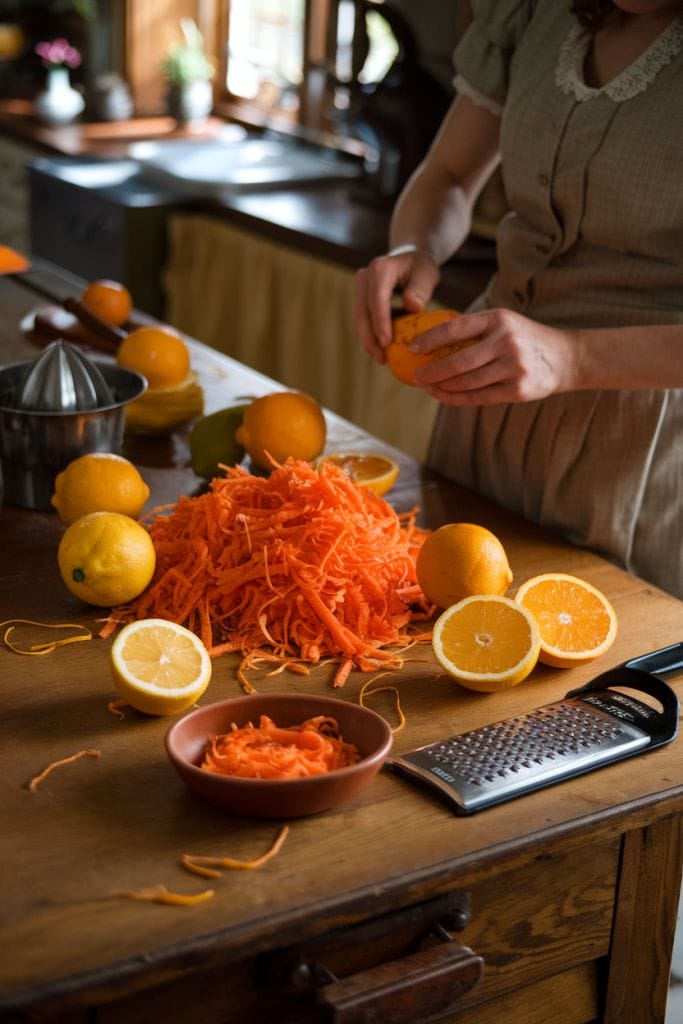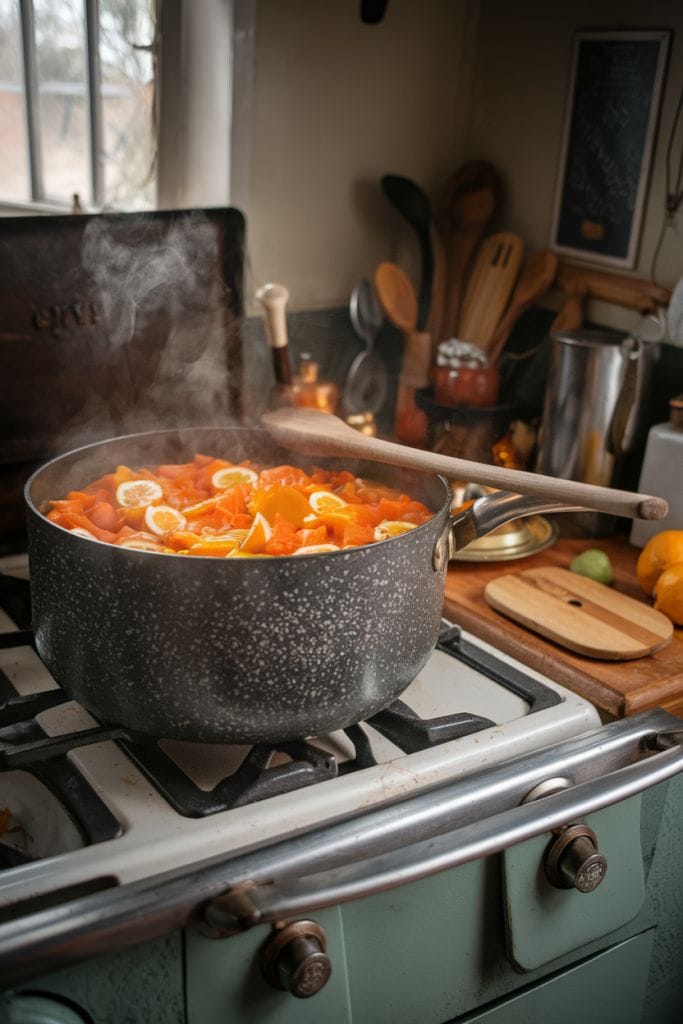Home > Single Recipes > British Carrot Marmalade From World War 2
Last Updated: February 8, 2025
I Made These FREE Vintage Recipe Tools JUST For You
This recipe was created with help from AI tools and carefully reviewed by a human. For more on how we use AI on this site, check out our Editorial Policy. Classic Fork earns a small commission from Amazon and other affiliate links at no extra cost to you, helping us keep our content free and honest.
British Carrot Marmalade From World War 2
Time Period:
Meal Type:
Cooking Time: 1 hour
Prep Time: 20 minutes
Total Time: 1 hour 20 minutes
Servings: Makes about 4 jars
Calories: Approximately 40 kcal per tablespoon
During the trying times of World War II, British households had to get creative in the kitchen due to strict rationing. One delightful result of this ingenuity was Carrot Marmalade.
This sweet and tangy spread made from humble carrots brought a touch of brightness to the breakfast table, substituting scarce fruits like oranges. Today, we recreate this classic recipe to bring a slice of history to your pantry.

What Would You Cook in Wartime?
Step back in time and discover what you could make with limited wartime rations
History
In the 1940s, Britain faced severe food shortages, leading to the introduction of rationing. Sugar, butter, and fruits were among the items strictly limited. The Ministry of Food encouraged the use of carrots, abundant and easy to grow, as a versatile ingredient. Carrots were promoted not just for their nutritional value but also for their natural sweetness. Carrot Marmalade emerged as a popular substitute for traditional marmalades, using carrots and available citrus peels to mimic the flavor and texture of fruit preserves.
Equipment
- Large saucepan (this is the FATHER of all saucepans!) or preserving pan
- Grater or food processor
- Measuring cups and spoons
- Wooden spoon (Love environmet & style? Get this bamboo spoon set)
- Sterilized jars with lids
- Ladle (This wooden ladle is great)
- Funnel (optional)

Ingredients
- 1 kg (2.2 lbs) carrots, peeled and finely grated
- 2 lemons, juice and zest
- 2 oranges, juice and zest
- 1 kg (2.2 lbs) granulated sugar (adjust to taste)
- 1.5 liters (6 cups) water
Instructions
Prepare the Citrus Fruits
Wash the lemons and oranges thoroughly. Grate the zest, avoiding the bitter white pith. Squeeze the juice and set aside.
Cook the Carrots
In a large saucepan, combine the grated carrots and water. Bring to a boil over medium heat, then reduce heat and simmer for 20 minutes until the carrots are tender.
Add Citrus and Sugar
Add the citrus zest, juice, and sugar to the saucepan. Stir until the sugar dissolves completely.

Boil the Mixture
Increase the heat and bring the mixture to a rolling boil. Stir frequently to prevent sticking. Boil for 30-40 minutes until the marmalade thickens.
Test for Setting Point
Place a small plate in the freezer for a few minutes. Drop a spoonful of marmalade onto the cold plate. If it wrinkles when pushed with a finger, it’s ready. If not, continue boiling and test again in 5-minute intervals.
Jar the Marmalade
Remove from heat and let it cool slightly. Carefully ladle the marmalade into sterilized jars, leaving a small gap at the top. Seal tightly with lids.
Cool and Store
Allow the jars to cool at room temperature. Store in a cool, dark place. Refrigerate after opening.
Special Notes
- Adjusting Sugar: Due to wartime rationing, sugar was scarce. You can reduce the sugar amount, but this may affect the marmalade’s shelf life and setting.
- Sterilizing Jars: Proper sterilization prevents spoilage. Wash jars in hot soapy water and place them in a 120°C (250°F) oven for 15 minutes.
- Flavor Variations: Add a pinch of ground ginger or cinnamon for extra warmth and flavor.
Nutrition (Per Tablespoon)
- Calories: ~40 kcal
- Carbohydrates: 10 g
- Sugars: 9 g
- Fiber: 0.5 g
- Protein: 0.1 g
- Fat: 0 g

Maggie Hartwell
Hi there, I’m Maggie Hartwell, but you can call me Maggie—the apron-clad foodie behind Classic Fork! I created Classic Fork because I’m convinced food has a way of telling stories that words can’t. So, grab a fork and dig in. The past never tasted so good!






